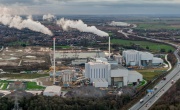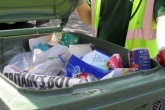Food waste collections boost NI recycling rate to 47.1 per cent
Northern Ireland’s recycling rate for the last three months of 2017 has jumped to 47.1 per cent, an increase of five points on the same period in 2016, which the Department of Agriculture, Environment and Rural Affairs (Daera) attributes to new regulations requiring councils to separately collect food waste.
In the latest quarterly update of Northern Ireland local authority municipal waste management statistics for October to December 2017, released by Daera last week (26 April), it was revealed that the household waste preparing for reuse, dry recycling and composting rate had increased from 42.1 per cent to 47.1 per cent, while total waste collected also increased from 228,145 tonnes to 232,004 tonnes – a jump of 1.7 per cent.
In the latest waste statistics report, Daera links the increased recycling rate to the new rules regarding the collection of food waste by councils, saying: ‘From April 2017, it became a statutory requirement for all councils in Northern Ireland to provide each household with a container for food (potentially with other bio-waste) to enable its separate collection. The purpose of this was to reduce the amount of this waste sent for disposal, if not collected separately it becomes contaminated/unrecyclable.
‘The impact of this can be seen… where all but one council increased their household recycling rate compared to the same quarter last year. Differences in composting rates across the council areas can also be affected by variations in the urban/rural characteristics of the council areas.’
In terms of individual councils, Lisburn & Castlereagh and Newry, Mourne & Down reported the greatest increases in recycling rates for October to December 2017 compared with the same period the previous year, with Lisburn & Castlereagh jumping 8.6 percentage points and Newry, Mourne & Down rising by 7.6 percentage points, with both registering increases in the household composting rate of 4.9 and 7.9 percentage points respectively.
Mid Ulster achieved the highest recycling rate of any Northern Irish council, with 54.6 per cent, while Causeway Coast & Glens brought up the rear with a respectable (in the context of UK recycling) 40.1 per cent.
The latest quarterly landfill rate for household waste was 32.3 per cent, a further reduction on the 38.1 per cent recorded during the same three months of 2016. There were 43,126 tonnes of local authority collected municipal waste sent to landfill between October and December 2017. This was 15.6 per cent lower than the 51,097 tonnes sent between the same three months of 2016. It also accounted for a smaller proportion of the annual allowance, 17.3 per cent between October and December 2017, compared to 19.4 per cent in the equivalent quarter of 2016.
If the increased recycling rate were to be replicated over a whole 12 months, Northern Ireland would overtake England in its position as the UK’s worst performing recycling nation, with England’s latest recycling rate standing at 44.6 per cent for 2016/17, while Northern Ireland’s was 44.4 per cent.
Despite the progress on food waste by the devolved administrations, the UK Government has so far proved resistant to calls to introduce mandatory collections of food waste across England, with the lack of commitments to such a policy in the government’s 25 Year Environment Plan considered a significant omission by many.
The full quarterly provisional estimates for Northern Ireland local authority collected municipal waste for October to December 2017 are available to view on the Daera website.






